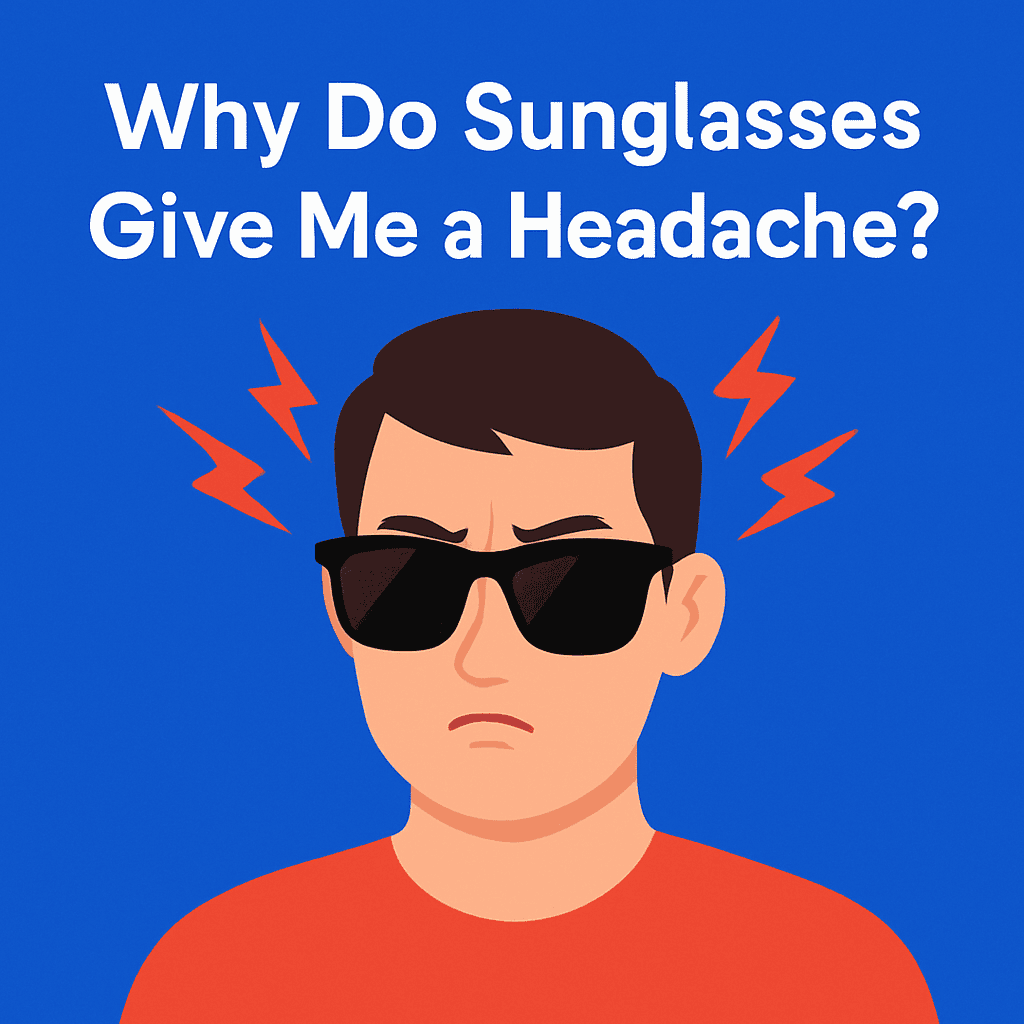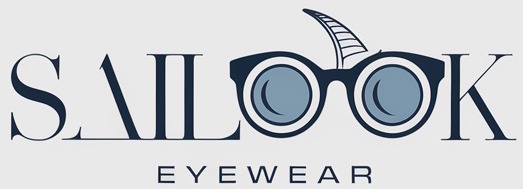Sunglasses are a staple accessory for many people. They protect our eyes from harmful UV rays, reduce glare, and offer style. However, for some individuals, wearing sunglasses can result in persistent headaches. This issue can occur due to various factors, including poor fit, the materials used, or the lens type. In this article, we will dive into the reasons why sunglasses cause headaches, how to choose the right pair to prevent discomfort, and offer practical tips to reduce headaches associated with sunglasses.

1. Why Do Sunglasses Cause Headaches?
Sunglasses can cause headaches for several reasons. Often, it’s due to poor fit, incorrect lens materials, or prolonged wear. When sunglasses are too tight, they exert pressure on the temples, the nose, or the ears, leading to tension headaches. What’s the real story? A key contributor to this issue is a mismatch between the shape of your face and the frame style of your sunglasses. If the sunglasses press against your face in uncomfortable places, the pressure builds up, resulting in headaches.
Another factor that causes headaches is the lens material. Some lenses are made of heavy or thick materials, which can cause strain on the eyes and surrounding areas. In addition, the type of lens can also have an impact. Poor quality lenses or lenses that are not designed to reduce glare can increase eye strain, especially when you’re in bright environments. But here’s the kicker: If your sunglasses don’t offer adequate UV protection, your eyes may need to work harder to adjust to the light, contributing to headache development.
| Reason for Headache | Explanation |
|---|---|
| Poor Fit | Pressure on the temples or nose pads can cause discomfort and tension headaches. |
| Lens Material | Heavier or thicker lenses increase pressure on the eyes and surrounding areas. |
| UV Protection | Inadequate UV protection forces eyes to work harder, leading to eye strain. |
2. How Can the Fit of Your Sunglasses Lead to Headaches?
The fit of your sunglasses is one of the most common causes of discomfort and headaches. Here’s the deal: If the sunglasses are too tight, they place undue pressure on your head and face, leading to discomfort and headaches. Specifically, tight temples can press against your skull, and poorly adjusted nose pads can create uncomfortable pressure on the bridge of your nose.
In contrast, sunglasses that are too loose can slide down your face, forcing you to adjust them frequently. This constant repositioning can cause strain on the eyes, which can eventually lead to headaches. What’s the real story? Sunglasses that don’t properly sit on your face create discomfort, making it difficult for you to focus, causing fatigue, and eventually a headache.
To prevent headaches caused by poor fit, it’s important to choose sunglasses that are adjustable or tailored to your face shape. Ensure that the nose pads are soft, adjustable, and properly positioned to distribute the weight evenly across your nose. A proper fit will reduce pressure and alleviate the chances of discomfort.
| Fit Issue | Effect on Headaches |
|---|---|
| Tight Temples | Can cause painful pressure points on the sides of the head. |
| Poor Nose Pads | Leads to concentrated pressure on the bridge of the nose. |
| Loose Sunglasses | Increases eye strain due to constant adjustments. |
3. Can the Shape of the Lenses Affect Your Comfort?
The shape of the lenses in your sunglasses can also contribute to discomfort. Ready for the good part? Lenses that are curved or wraparound can press against the sides of your head and temples, causing pressure points. These designs are meant to offer better coverage and protection, but they can sometimes feel restrictive, leading to discomfort and headaches.
Flat lenses, on the other hand, are typically more comfortable, as they don’t push against your face as much. However, the trade-off is that they may not offer as much protection against wind and sunlight. This is where it gets interesting: The curvature of the lenses affects how light enters your eyes, and an uncomfortable fit can lead to eye strain. The shape of the lenses can cause your eyes to work harder to focus, leading to headaches over time.
To minimize discomfort, choose sunglasses with lenses that are shaped appropriately for your face and your needs. Some lenses feature advanced technologies that help to minimize glare without the need for excessive curvature.
| Lens Shape | Comfort Impact |
|---|---|
| Curved Lenses | Can press against the face and temples, causing discomfort. |
| Flat Lenses | Less pressure but potentially less protection from sunlight and wind. |
| Wraparound Lenses | Offer full coverage but may increase pressure around the temples. |
4. Are Certain Lens Materials More Likely to Cause Headaches?
Lens material plays a significant role in the comfort of your sunglasses. What’s the catch? Heavier lens materials like glass or thick plastic may create unnecessary strain, making your eyes work harder. Thicker lenses are more prone to causing pressure on the face, which can lead to headaches.
On the other hand, lighter materials like polycarbonate and Trivex are often used in high-performance sunglasses because they provide better comfort. You might be wondering how these materials contribute to comfort. The lighter materials reduce the pressure on your face, making the sunglasses feel more natural to wear.
Additionally, lens coatings like anti-glare or anti-scratch coatings can reduce the amount of light reflecting into your eyes, reducing eye strain. Choosing sunglasses with high-quality materials and coatings can minimize discomfort and prevent headaches.
| Lens Material | Comfort Impact |
|---|---|
| Glass | Heavy and thick, which can cause pressure on the temples. |
| Polycarbonate | Lightweight and more comfortable for prolonged use. |
| Trivex | Similar to polycarbonate but offers better impact resistance. |
5. How Do UV Protection and Polarized Lenses Affect Your Eyes?
UV protection is a crucial factor in the comfort of your sunglasses. Here’s the kicker: Sunglasses without adequate UV protection force your eyes to adjust to the light, increasing strain and possibly leading to headaches. UV radiation can harm the eyes over time, leading to various vision issues. Therefore, choosing sunglasses with 100% UV protection is essential.
Polarized lenses help reduce glare from reflective surfaces, such as water, snow, or roads, making them especially useful for those who spend time outdoors. This is where it gets interesting: Polarized lenses reduce glare, improving visibility and comfort, thus reducing eye strain and the likelihood of headaches. For people who experience frequent headaches while outdoors, choosing sunglasses with both UV protection and polarized lenses can make a significant difference.
| Lens Feature | Benefit |
|---|---|
| UV Protection | Reduces strain and prevents long-term damage to the eyes. |
| Polarized Lenses | Minimizes glare and reduces eye strain, preventing headaches. |
| Combined Protection | Provides optimal comfort by blocking harmful rays and glare. |
6. Can Wearing Sunglasses for Long Periods Lead to Headaches?
Wearing sunglasses for extended periods can cause discomfort and headaches. But here’s the kicker: The muscles around your eyes and temples can become fatigued from maintaining a constant focus, leading to tension headaches. If the sunglasses are not properly adjusted, this effect is worsened.
When wearing sunglasses for long durations, it’s essential to take breaks. What’s the real story? Short intervals without sunglasses allow your eyes to relax and reduce strain. Also, make sure your sunglasses are comfortable enough for long-term use by ensuring a proper fit and lightweight lenses.
| Wearing Duration | Effect on Comfort |
|---|---|
| Short-term Wear | Minimal strain on eyes and face. |
| Prolonged Wear | Leads to eye strain, fatigue, and potential headaches. |
| Breaks | Reduces strain and provides comfort during extended wear. |
7. Do Prescription Sunglasses Have the Same Effect?
Prescription sunglasses may cause headaches for some individuals, especially if they are improperly fitted. What’s the real story? Prescription lenses may not always align with the frame of the sunglasses, leading to discomfort or strain on the eyes. Furthermore, if your prescription is incorrect, it can exacerbate eye strain, causing headaches.
For those who experience headaches with prescription sunglasses, adjusting the prescription or frame fit may help. Regular eye exams are crucial to ensure that your prescription is accurate and suitable for your sunglasses.
| Prescription Issue | Headache Impact |
|---|---|
| Incorrect Prescription | Causes eye strain, leading to headaches and discomfort. |
| Poor Frame Fit | Incorrect frame alignment can cause pressure on the face and head. |
| Regular Eye Exams | Ensures the prescription is up-to-date and comfortable for use. |
8. Is Your Vision Health Contributing to the Problem?
Vision problems can make wearing sunglasses uncomfortable, especially if they are not properly corrected. This is where it gets interesting: If you have an underlying vision issue such as astigmatism or presbyopia, your sunglasses may cause additional strain. Uncorrected vision issues can lead to eye fatigue and headaches, even when wearing high-quality sunglasses.
Regular visits to an eye care professional can help identify and correct these vision issues. By ensuring your prescription is accurate and updated, you can reduce the risk of headaches caused by sunglasses.
| Vision Issue | Effect on Headaches |
|---|---|
| Astigmatism | Causes distorted vision, increasing strain and discomfort. |
| Presbyopia | Leads to blurred vision, resulting in eye strain. |
| Uncorrected Vision | Forces the eyes to work harder, leading to headaches. |
9. Can Lens Tint Cause Headaches?
The tint of the lens can also contribute to discomfort. What’s the real story? Different tints affect the way light is filtered through the lens. Tints that are too dark or too light can strain your eyes as they struggle to adjust to varying light levels. The wrong tint can cause eye fatigue, leading to headaches.
Opt for a tint that matches your environment and activity. For example, a gray tint helps reduce overall brightness without distorting colors, making it a comfortable option for most activities.
| Tint Type | Effect on Comfort |
|---|---|
| Dark Tint | Can cause strain in low-light environments. |
| Light Tint | May cause discomfort in bright sunlight. |
| Gray Tint | Offers a balanced solution for general use. |
10. How Can You Choose the Right Sunglasses to Prevent Headaches?
Choosing the right sunglasses is key to preventing headaches. Here’s the kicker: Look for sunglasses that are lightweight, have adjustable nose pads, and are made from materials like polycarbonate or titanium. Sunglasses that fit well and don’t press against your face are more comfortable to wear for extended periods.
Consider the lens type as well. Polarized lenses that block glare, along with UV protection, help reduce eye strain and prevent headaches. When selecting sunglasses, always try them on to ensure they fit comfortably and don’t press too hard on any part of your face.
| Sunglass Feature | Benefit |
|---|---|
| Lightweight Frames | Reduces pressure on the face, preventing strain. |
| Adjustable Nose Pads | Allows for a more comfortable and personalized fit. |
| Polarized Lenses | Reduces glare, decreasing strain and preventing headaches. |
11. Are There Sunglasses Designed Specifically to Prevent Headaches?
Yes, there are sunglasses specifically designed to reduce the risk of headaches. What’s the catch? These sunglasses often have lightweight frames, adjustable features, and high-quality lenses designed to minimize glare and eye strain. Many brands offer ergonomic designs that contour to your face, ensuring a comfortable fit.
Sunglasses with flexible temples, soft nose pads, and lightweight materials help distribute pressure evenly and prevent discomfort. Some brands also offer glasses with adjustable temples and interchangeable lenses for optimal comfort.
| Design Feature | Benefit |
|---|---|
| Ergonomic Design | Contours to the face for a comfortable fit. |
| Flexible Temples | Helps distribute pressure evenly. |
| Adjustable Nose Pads | Provides a customizable fit to reduce discomfort. |
12. What Should You Do If Sunglasses Cause You a Headache?
If you experience headaches from sunglasses, there are a few steps you can take. Ready for the good part? Start by adjusting the fit. If the temples are too tight or the nose pads are too hard, try loosening them. Visit an optometrist to ensure your prescription is up-to-date and accurate.
If the issue persists, it may be worth trying a different lens material or tint. Ensure that your sunglasses offer proper UV protection and are polarized to minimize glare.
| Adjustment | Effect on Comfort |
|---|---|
| Adjust the Fit | Loosening the temples or adjusting nose pads can relieve pressure. |
| Visit an Optometrist | Ensures the prescription is accurate and suits the sunglasses. |
| Try Different Lenses | Experiment with different lens types for better comfort. |
13. How Do Headaches from Sunglasses Compare to Other Eye Strain Issues?
Headaches from sunglasses are similar to other forms of eye strain, but they have unique causes. This is where it gets interesting: Unlike standard eye strain, which results from prolonged screen time or lack of rest, headaches from sunglasses are often caused by fit, material, or UV exposure.
While typical eye strain may lead to tiredness and blurry vision, sunglasses-related headaches are often accompanied by localized pain around the temples and nose. Identifying the specific cause of discomfort will help you choose the right corrective measures.
| Eye Strain Type | Cause |
|---|---|
| Regular Eye Strain | Caused by prolonged screen use or lack of breaks. |
| Sunglasses-Related Headaches | Result from poor fit, lens type, or UV exposure. |
14. Are There Other Accessories to Reduce Headaches Caused by Sunglasses?
Other accessories can complement your sunglasses to reduce strain and prevent headaches. What’s the real story? Using a hat or visor can provide additional shade, reducing glare and light sensitivity. Anti-glare coatings on lenses can also help reduce strain from reflections.
Additionally, regularly cleaning your lenses ensures that you get the clearest possible view without added strain. These small adjustments can go a long way in preventing headaches caused by wearing sunglasses.
| Accessory | Benefit |
|---|---|
| Hat or Visor | Provides extra shade, reducing glare. |
| Anti-Glare Coating | Reduces glare from reflective surfaces. |
| Lens Cleaning | Ensures optimal clarity, reducing eye strain. |
15. Conclusion: How Can You Prevent Future Headaches from Sunglasses?
In conclusion, preventing headaches from sunglasses requires a combination of proper fit, lens quality, and careful selection of materials. By ensuring that your sunglasses fit well, are made from lightweight materials, and offer adequate UV protection, you can significantly reduce the chances of experiencing discomfort.
Remember to choose sunglasses with adjustable features and high-quality lenses, and always prioritize comfort. Regular adjustments and proper care can also improve the lifespan of your sunglasses while preventing headaches in the future.
| Preventive Measure | Effect |
|---|---|
| Proper Fit | Reduces pressure and discomfort. |
| High-Quality Lenses | Minimizes strain and provides comfort. |
| Regular Adjustments | Ensures comfort over time and reduces the risk of headaches. |
FAQ Section
Q1: What is the main cause of headaches when wearing sunglasses?
Headaches often result from poor fit, lens materials, or insufficient UV protection, which causes eye strain and discomfort.
Q2: How does the wrong fit lead to discomfort in sunglasses?
Sunglasses that are too tight on your temples or nose can create pressure points, leading to tension headaches.
Q3: Are polarized lenses better for preventing headaches?
Yes, polarized lenses reduce glare, which helps decrease eye strain and the likelihood of headaches.
Q4: Can I prevent headaches from prescription sunglasses?
Adjusting the fit of your prescription sunglasses and ensuring your prescription is up-to-date can help prevent headaches.
Q5: How can I tell if my sunglasses are causing my headaches?
If you experience discomfort or pain shortly after wearing your sunglasses, it may be due to pressure from the frames or poor-quality lenses.

